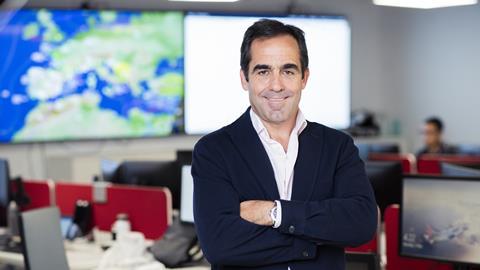After a turbulent three years amid the pandemic and then the impact of rapidly rising fuel costs, Volotea under founding chief executive Carlos Munoz has renewed confidence thanks to a strong 2023 and encouraging start to this year
In an airline industry where conventional wisdom tends to trump innovation when it comes to business models, Barcelona-based Volotea stands out as a rare example of a carrier that continues to defy traditional categorisation.
“We have this very differentiated, unique strategy, putting together Europe’s mid-sized and small cities,” says Volotea co-founder and chief executive Carlos Munoz during an interview with Airline Business in late February.
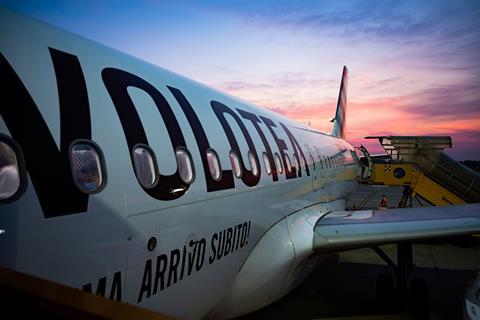
Some 14 years into operations, the carrier’s successful implementation of that strategy has put it on the verge of what Munoz hopes will be an IPO, maybe this year, following a vastly improved financial performance in 2023.
Focused on thin leisure and VFR routes in its core markets of France, Italy and Spain, alongside operations in Greece and Germany, Volotea achieved record revenue and margins in 2023, Munoz says, although the business is yet to release detailed results.
In 2024, Volotea expects to serve around 11.5 million passengers, he says, versus 7.6 milion in 2019. Revenue is projected at €820 million ($898 million), which is not far off double that achieved in 2019.
That is strong evidence, Munoz insists, that while Europe’s biggest low-cost carriers have business models that make money by connecting large population centres with high-frequency, year-round service, using relatively young fleets and streamlined distribution channels, Volotea has carved a successful niche – often by doing the very opposite of those things.
“We are off the beaten track and we have a lot of routes without competition,” Munoz states. “We use mid-life fleet [and] we have high seasonality.”
But while he is able to be optimistic about the future today, the Covid era and war in Europe tested Volotea’s financial and strategic resilience in significant ways.
EXTENDED STRUGGLES
“Financially we did have a pretty bad couple of years with Covid, which in our case was extended one more year,” Munoz recalls.
Crucially, while the peak Covid-19 years of 2020 and 2021 were challenging in financial terms – even as the carrier circumnavigated travel restrictions by pivoting from a 50:50 domestic/international route split to being 90% focused on the former – it was actually 2022 that hit hardest.
The problem for an unhedged Volotea – the carrier’s usual hedging efforts having been paused during the Covid crisis – was the effect Russia’s invasion of Ukraine had on fuel prices.
“Thank goodness 2023 turned around big time and we’ve seen very strong demand and much better costs than pre-Covid,” he says.
“2023 changed positive and 2024 has started pretty strong.”
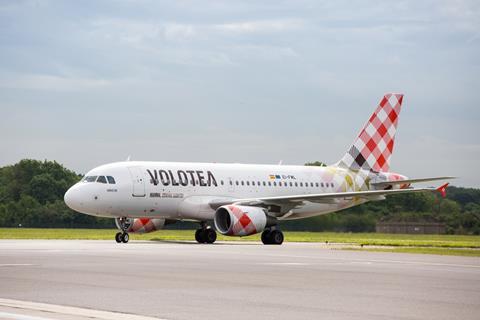
But the impact of those challenging three years is still being felt by the business today.
“We survived by raising €360 million of debt,” Munoz explains. “We’ve returned some of that [but] we still have a long way to go.”
Indeed, the carrier has so far repaid €40 million of a €150 million syndicated loan taken with eight banks in 2020, Munoz says.
Meanwhile, repayment of a €200 million loan taken in 2022 is due through a “bullet payment” in 2029.
“We hope, and I think we will, to return it before that,” he says.
The remaining €10 million in loans was injected by the airline’s shareholders.
Munoz is understandably keen to put those challenging years behind the business, and with Volotea shifting to positive financials in 2023, he notes that an IPO is again “of very high interest”.
“Hopefully this year,” he replies when asked when that might happen. “I cannot guarantee it because it’s market mood dependent.
“But we’ve met investors – they like the story and value our unique strategy and, yes, an IPO would be a very good thing.”
VARIABLE COST BASE
Critical to Volotea’s differentiated strategy is the variable cost base that means the business is able to operate in highly seasonal markets – a complexity that most carriers would shy away from.
“Our complexity comes most because of the seasonability,” Munoz explains. “You can always look at it as a hurdle or an advantage, and it has both things.
“For us, we definitely like the advantage side of it. Why these markets are ours, why we have close to 60% of our ASKs without competition, is for two reasons: one is they are smaller, the second is they are seasonal.”
Munoz declines to detail how the business variabilises its cost base, only saying that it “sets Volotea apart”.
Something else setting Volotea apart from other ultra-low-cost carriers – Munoz puts his carrier’s cost base in the same ball park as Ryanair and Wizz Air, rather than EasyJet – is its fleet strategy.
“From all the companies that I know, we are the only airline, low-cost or not, that has CASK ex-fuel lower than pre-Covid,” he states.
That was made possible by Volotea’s decision during the Covid-19 downturn to phase out the Boeing 717s that dominated its fleet for its first nine years of operations, in preference for Airbus A320-family jets.
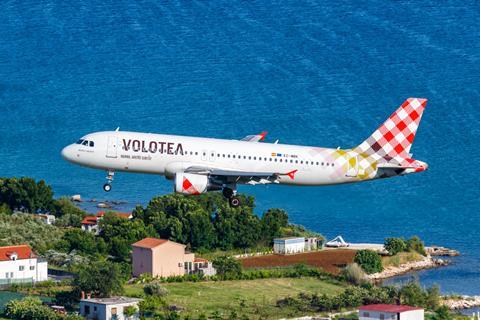
“We used to have a plane that we liked but it wasn’t financially, especially cost-wise, optimal,” Munoz says of the 717. “We used the crisis to negotiate with Boeing to accelerate the early the retirement of all that fleet.”
In a move that Munoz says was necessary for the airline “to survive”, Volotea has taken on a mixture of mid-life A319s and A320s through a small group of trusted lessor partners. That means it now offers a minimum of 150 seats per flight (the A319) up to 180 with its largest aircraft (the A320), while the 717s featured just 125 seats.
With the three extra A320-family jets Volotea is taking in 2024, its fleet will grow to 44 of the type for this year’s summer peak months.
And while Volotea is experiencing all of the cost pressures that carriers are being hit by in the current inflationary environment, “the cost efficiency from the [A]320s has more than offset all the other factors”, Munoz states.
Having two aircraft variants does not add complexity to the business, Munoz insists, while noting that the “mechanics are the same, the pilots are the same”.
Rather, Volotea enjoys the flexibility of being able to assign larger aircraft based on market demand, giving it “play” on the RASM and CASM.
“I see that as a gain – a way to optimise,” he states.
Furthermore, the timing of Volotea taking on the mid-life A320s, plus its shift away from what was a niche aircraft in the current era, means it has avoided the worst of the MRO challenges and parts shortages that are weighing on much of the industry today.
“From an MRO perspective we’re comfortable,” he says.
“We came from the world of Boeing 717 where for everything there was one supplier,” Munoz says. “So going to an Airbus 320-family world in maintenance… is better than I had.”

In the context of the industry’s sustainability challenges, A320-family jets have also brought a step-change in terms of fuel efficiency, although Munoz still acknowledges that Volotea’s mid-life fleet “is one negative compared with other low-cost carriers which are based on the use of larger, newer planes”.
But he argues that Volotea “compensates” for that with the “very high value” of the connectivity the airline offers.
“I connect islands big time; I connect places that don’t have alternatives; I connect zero routes where train travel would take under five hours,” he explains. “The big thing on this debate between sustainability and connectivity [is that] the higher the value of your connectivty, the more you shape that.”
Volotea feels the sustainability pressure acutely, he observes, with its biggest operation in France “now the most progressive market” in terms of public and governmental pressure on the sector’s environmental footprint.
“It’s an absolute must-do,” he says of the airline’s sustainability efforts, which also include the use of sustainable aviation fuel and investment into alternative propulsion systems.
LONGER PEAK
Beyond its fleet overhaul, a further cost improvement has come in recent years from the expansion of the peak seasons in markets that have matured since Volotea created them, Munoz says. This is a slow process, he notes, but is nevertheless an important one.
“Slowly but surely, in small markets, over time, you expand the seasons more,” he states. “So we actually see gains in the utilisation, especially on what we call the shoulders.
“We used to be a very peaky airline, June-September, now we see shoulders that are any time from late March until June. And the back shoulder, mid-September through end October, we see much higher activity.
“So we see slowly, increased utilisation, which is very good for your unit cost.”
It is in the development of its bases that Volotea is also unique compared with other low-cost operators, Munoz says, noting that the carrier has only closed one base – Genoa in Italy – since its launch.
Volotea will operate from 21 bases in 2024, with the opening of Bari and Brest.
Describing airports as the airline’s partners, Munoz explains: “Our track record is pretty good with the cities, regions and airports that we base ourselves in because they know we are going to put not just seats in, but differentiated seats compared to what they had before.”
Each year, he explains, Volotea’s growth is based on a competitive tender process.
“We don’t look at it on a country-by-country basis, we look at it city-by-city and which is underconnected,” he states.
“We always have a long list of small and mid-cities in Europe that remain not ideally supplied.
“We run every year a tender and typically there will be 8-10 participants, five finalists and we will end up choosing one that we will invest in, and then we invest big time – start a base, with lots of local employment.”
He characterises the airline’s approach as “co-operative low-cost” as opposed to the “against-everyone low-cost” approach that other budget carriers might adopt, where airports are sometimes quickly dropped based on small changes in economics.
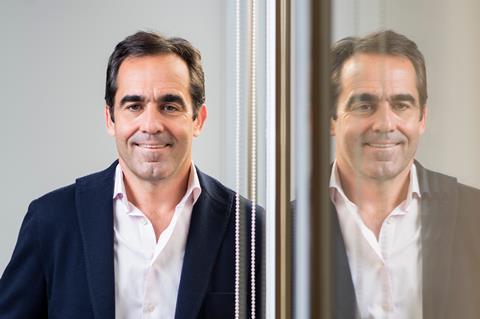
The results of Volotea’s more long-term approach are reflected in the example of its largest base, Nantes, Munoz says.
“I have nine aircraft and we have 56 destinations, something like that,” he says of the French city. “I think the maximum Air France ever got to there was probably 15 [destinations] – so just the number of destinations that we bring, the breadth of network is transformative and I know we still see potential.”
He gives another example of Brest, where Volotea is opening a base this year.
“In the corner of Brittany… we are putting in 20 routes and 13 or 14 of them did not exist before,” he states. “So you are connecting people from Brittany with a lot of places, either a destination for them or a source of traffic [from] visitors to [the region].”
And Munoz notes that Volotea has got better at choosing those differentiated routes.
“The key is to be very, very flexible,” he says. “At the beginning, our failure rate with routes in year one was 40%. So we opened 90 routes and we closed 40 or so.
That failure rate has decreased to about 5% today, he estimates.
“We launch, every year, 40, 50, 60 new routes… even during Covid a couple of bases per year, so it’s essentially our DNA.”
LOCAL REPUTATION
In building its market presence, Volotea must also be cognisant of its reputation among a local community.
“In smaller cities and smaller communities, reputation matters a lot,” Munoz says. “We’re very aware of that. And because word of mouth is so critical, for us to have a recommendation rate above 90% or to have an NPS around 40% is a very big deal.”
So, while he acknowledges that “price matters a lot” when it comes to low-cost travel – “being a low-cost guy for the past 20 years, no one needs to convince me about that one,” Munoz says – Volotea also makes small adjustments to its product to reflect “idiosyncrasies” in the different European markets.
“If you think about my core five markets, which are France, Italy, Spain, then smaller Greece and Germany, those all behave differently, and people react differently,” he states.
Corporate travel does not loom large in Volotea’s passenger base, Munoz says, with leisure travellers and VFR markets being the main focus of its product offering.
He cites students travelling across France or north-to-south in Italy, and different generations of people travelling from Europe’s islands to mainland cities as examples of the types of traffic Volotea tends to attract – and target its product at.
Munoz notes that beyond the airline’s core strategy, it has added public service obligations (PSO) operations – which account for up to 10% of the airline’s business – to its slate in recent years, while it also operates the Airbus shuttle between Hamburg and Toulouse.
Volotea is always open to expanding beyond its core markets, Munoz says, but notes that labour considerations and the competitive environment need to be carefully considered in terms of how they fit into the airline’s business model.
Outside its main markets, the carrier’s Greek operations are underpinned by a codeshare agreement with Aegean Airlines covering around 100 routes, while it cross-sells on nearly 200 routes in Germany through an agreement with Lufthansa Group’s low-cost arm Eurowings.
Munoz says there is potential for those partnerships to expand.
But asked whether they could be a precursor to Volotea’s direct involvement with consolidation in the European airline sector, Munoz responds: “We love being one of the few independent mid-sized carriers in Europe.
“It brings lots of opportunity.”
Other potential consolidation moves could, however, bring fresh opportunities for the carrier, he says, particularly in Volotea’s home market, where IAG’s attempts to purchase Air Europa might involve remedies that benefit Volotea as a “guarantor of connectivity”.
“Spain in particular is a big interest to us,” Munoz says. “We are based in Barcelona but we have three markets that are bigger than this one.
“Growing in Spain in the mid-term would be great and if there is consolidation it could help us with that,” he adds.
It is opportunities like that which will keep Munoz and his leadership team busy as they plot Volotea’s next moves.
As that plays out, Munoz is confident that the carrier has got the fundamentals to grow profitably in the coming years while it pays off its loans.
“People like Volotea and choose Volotea because of its prices and because we offer routes that are unique,” he states.
“We keep on connecting more cities, and people seem to like it even more.”
INSPIRING EXPERIENCES
Carlos Munoz cites two key inspirations for the Volotea business model: his experience with founding Spanish low-cost carrier Vueling and his observations of Allegiant Air’s growth in the USA.
“I was also founding chief executive of Vueling,” he states. “In those early days, in the first five years of Vueling, we would find… essentially, and I am generalising here, but anything that touched Barcelona, Madrid, Paris, Milan or Rome, which were our core five markets, generally speaking worked.
“Whereas when we went off those markets and went to smaller markets, it typically did not work.”
The issue, he says, is that while the low-cost model is “very powerful”, it was created for certain types of traffic and market.
“Below that, you needed to adjust the model,” he says. “We started with smaller aircraft. We were the only low-cost using mid-life aircraft, distribution not only on the web… There are a bunch of differences in the operational model that you needed to tweak.
“That came from Vueling and seeing what didn’t work.”
He gained further insight from studying Allegiant’s business strategy.
“Once we’d concluded that that was the market and how to do it… we went so many times to [Las] Vegas [to see the approach taken by Allegiant executives such as] Maury Gallagher, Andrew Levy, Jude Bricker and Lukas Johnson.
“They were super flexible and looking outside the box in terms of low-cost.”
Volotea did “borrow from their toolbox”, Munoz says of Allegiant, but notes the two airlines “are very different”, not least because in market terms, “there is no Las Vegas or Florida equivalent in Europe”.
Still, “a lot of things separate both of us from the core low-cost carriers or ULCCs,” Munoz says.
AI REVOLUTION?
Technology is a key focus for Volotea, Munoz says, noting that the business’s data science team is a “total blessing” for the carrier – particularly when it comes to using AI.
“It’s phenomenal,” he states. “We started more on the commercial side, then we started putting it into operations.”
One example of AI in action is for tail assignment optimisation, Munoz explains.
“Checking all your network, putting data science into that and using machine learning is big-time helpful and transformative,” he says.
Another AI application is ancillary and revenue management.
“Every tool we have on ancillary or revenue management is home-grown and it’s very much using that; 44% of our revenue is ancillaries so it suggests we’re doing good,” he says.
“And I think all companies will be using it more and more, and our industry will benefit from it a lot.”


